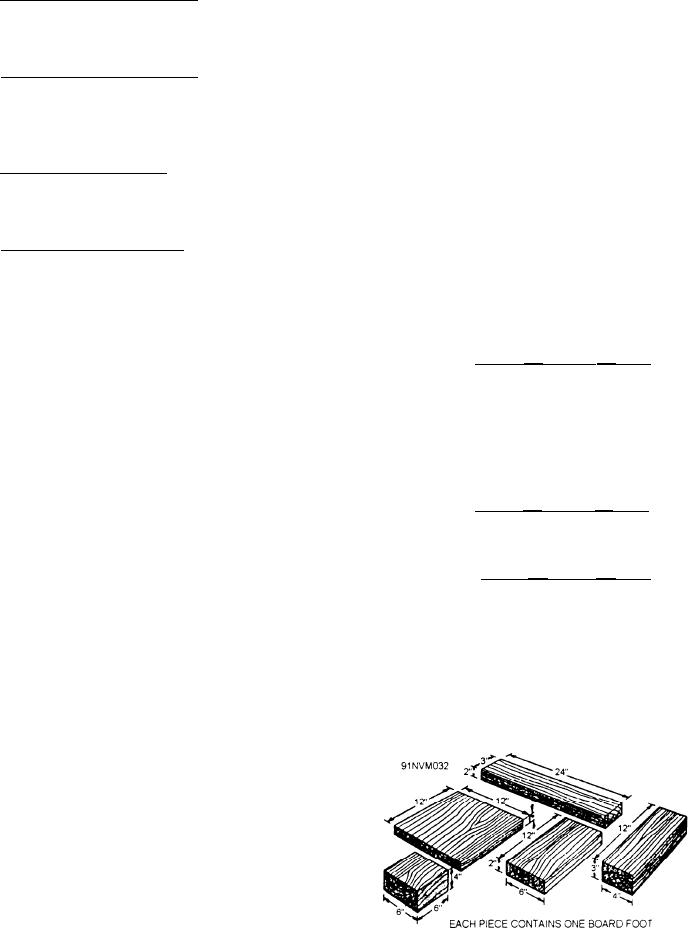
It is common practice to state the thickness
defects. It must be suitable for use as watertight
dimension in inches first; the width in inches second;
lumber.
and the length in feet last. For example, if you were
told to get a 2 by 4 by 6, you would know to get a
N o . 2 common lumber. This lumber
board 2 inches thick by 4 inches wide by 6 feet long.
contains a few significant defects, but no knotholes
or other serious defects.
The standard measure for lumber is a board
foot. This is abbreviated as bf or bd ft. A board
N o . 3 common lumber. This lumber
foot is simply one-twelfth of a cubic foot. A board
contains a few defects that are larger and coarser
measuring 1 inch thick, 12 inches wide, and 12
than those in No. 2 common; for example,
inches long contains 1 bd ft. Figure 3-6 shows
occasional knotholes.
different size pieces of wood. Each one contains 1
bd ft.
No. 4 common lumber. This lumber is low
quality and contains serious defects like knotholes,
You may use several formulas to determine bd
checks, shakes, and decay.
ft. The one most commonly used is the inches,
inches, feet method. To use it, multiply the
No. 5 common lumber. This lumber is
thickness (T) in inches by the width (W) in inches
capable only of holding together under ordinary
by the length (L) in feet. Next, divide the product
handling.
by 12. Write the formula as follows:
Mill-run lumber is everything that is sawed
except the slabs (bark). Some associations use
bd ft = T(in.) W(in.) L(ft.)
grades of construction known as standard, utility,
and economy.
12
Suppose you want to determine the bd ft
All species of lumber are covered by the grading
rules and size standards of some association or
contained in a piece of wood measuring 1 inch thick
grading bureau. Softwood lumber standards are set
by 8 inches wide by 9 feet long. Using the formula,
you would work it like this:
by a regional association of manufacturers. In a few
cases, a softwood species growing in more than one
bd ft = T(in.) W(in.) L(ft.)
region is graded under rules of two different
12
associations. It is better to buy according to these
association grades than to try to buy according to
1(in.) 8(in.) 9(ft.)
individualspecifications, unless the requirements are
bd ft =
very unusual. Occasionally a departure from the
12
standard grade provision is necessary. This is
handled as an exception to a standard grade.
bd ft = 6
Hardwoods are graded as firsts, seconds, selects,
No. 1 common, and No. 2 common. These grades
indicate only the amount of clear usable lumber in
Therefore, a board measuring 1 inch by 8 inches by
a particular piece. They are established by the
9 feet will contain 6 bd ft.
National Hardwood Manufacturers' Association.
The way to buy hardwoods for any use other than
construction is by personal inspection.
MEASURING LUMBER
When you are measuring lumber, thickness is the
dimension between the two face surfaces, Width is
the dimension between the two edges that are
parallel to the wood grain. Length is the dimension
between two ends and is parallel to the wood grain
regardless of the width dimension.
Figure 3-6.--The board foot.
3-6

